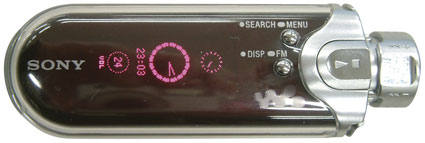'Digital Something'에 해당되는 글 28건
- 2005.02.22 소니의 새로운 MD 1
- 2004.11.30 산요의 컨셉폰 ... 3
- 2004.11.16 The technology behind Google's great results
- 2004.11.16 Firefox 1.0 한글판 release .....
- 2004.11.11 Gmail officially POP3 enabled!
- 2004.11.11 종이에 무선 전송이 가능한 칩을 삽입
- 2004.11.10 SanYo의 컨셉폰 5
- 2004.11.10 Prosolid by Panasonic 2
- 2004.11.07 이런 일도 생기는군요 ...
- 2004.11.07 오호라 ...

역시 소니 디자인 잘 만든다 ..
끌리게 만드네 .. 튀면서도 끌리게 만들다니 .. 쩝 ..
놀라운 재능이다 .. (돈이 많은건가 ??? )....
아직 떠도는 이야기로는 일어와 영어만 지우너 한다는데 ..
과연 어떻게 될지 ...
뭐 IPOD가 있는 나로서는 지름의 대상은 아니리라 생각된다 ..^^



클리앙에 가면 좀더 상세히 정리되어 있다..
바로가기.
원문보기..
Google Technology
As a Google user, you're familiar with the speed and accuracy of a Google search. How exactly does Google manage to find the right results for every query as quickly as it does? The heart of Google's search technology is PigeonRank™, a system for ranking web pages developed by Google founders Larry Page and Sergey Brin at Stanford University.

Building upon the breakthrough work of B. F. Skinner, Page and Brin reasoned that low cost pigeon clusters (PCs) could be used to compute the relative value of web pages faster than human editors or machine-based algorithms. And while Google has dozens of engineers working to improve every aspect of our service on a daily basis, PigeonRank continues to provide the basis for all of our web search tools.
Why Google's patented PigeonRank™ works so well
PigeonRank's success relies primarily on the superior trainability of the domestic pigeon (Columba livia) and its unique capacity to recognize objects regardless of spatial orientation. The common gray pigeon can easily distinguish among items displaying only the minutest differences, an ability that enables it to select relevant web sites from among thousands of similar pages.
By collecting flocks of pigeons in dense clusters, Google is able to process search queries at speeds superior to traditional search engines, which typically rely on birds of prey, brooding hens or slow-moving waterfowl to do their relevance rankings.
When a search query is submitted to Google, it is routed to a data coop where monitors flash result pages at blazing speeds. When a relevant result is observed by one of the pigeons in the cluster, it strikes a rubber-coated steel bar with its beak, which assigns the page a PigeonRank value of one. For each peck, the PigeonRank increases. Those pages receiving the most pecks, are returned at the top of the user's results page with the other results displayed in pecking order.

Integrity
Google's pigeon-driven methods make tampering with our results extremely difficult. While some unscrupulous websites have tried to boost their ranking by including images on their pages of bread crumbs, bird seed and parrots posing seductively in resplendent plumage, Google's PigeonRank technology cannot be deceived by these techniques. A Google search is an easy, honest and objective way to find high-quality websites with information relevant to your search.
Data



PigeonRank Frequently Asked Questions
How was PigeonRank developed?
The ease of training pigeons was documented early in the annals of science and fully explored by noted psychologist B.F. Skinner, who demonstrated that with only minor incentives, pigeons could be trained to execute complex tasks such as playing ping pong, piloting bombs or revising the Abatements, Credits and Refunds section of the national tax code.
Brin and Page were the first to recognize that this adaptability could be harnessed through massively parallel pecking to solve complex problems, such as ordering large datasets or ordering pizza for large groups of engineers. Page and Brin experimented with numerous avian motivators before settling on a combination of linseed and flax (lin/ax) that not only offered superior performance, but could be gathered at no cost from nearby open space preserves. This open space lin/ax powers Google's operations to this day, and a visit to the data coop reveals pigeons happily pecking away at lin/ax kernels and seeds.
What are the challenges of operating so many pigeon clusters (PCs)?
Pigeons naturally operate in dense populations, as anyone holding a pack of peanuts in an urban plaza is aware. This compactability enables Google to pack enormous numbers of processors into small spaces, with rack after rack stacked up in our data coops. While this is optimal from the standpoint of space conservation and pigeon contentment, it does create issues during molting season, when large fans must be brought in to blow feathers out of the data coop. Removal of other pigeon byproducts was a greater challenge, until Page and Brin developed groundbreaking technology for converting poop to pixels, the tiny dots that make up a monitor's display. The clean white background of Google's home page is powered by this renewable process.
Aren't pigeons really stupid? How do they do this?
While no pigeon has actually been confirmed for a seat on the Supreme Court, pigeons are surprisingly adept at making instant judgments when confronted with difficult choices. This makes them suitable for any job requiring accurate and authoritative decision-making under pressure. Among the positions in which pigeons have served capably are replacement air traffic controllers, butterfly ballot counters and pro football referees during the "no-instant replay" years.
Where does Google get its pigeons? Some special breeding lab?
Google uses only low-cost, off-the-street pigeons for its clusters. Gathered from city parks and plazas by Google's pack of more than 50 Phds (Pigeon-harvesting dogs), the pigeons are given a quick orientation on web site relevance and assigned to an appropriate data coop.
Isn't it cruel to keep pigeons penned up in tiny data coops?
Google exceeds all international standards for the ethical treatment of its pigeon personnel. Not only are they given free range of the coop and its window ledges, special break rooms have been set up for their convenience. These rooms are stocked with an assortment of delectable seeds and grains and feature the finest in European statuary for roosting.
What's the future of pigeon computing?
Google continues to explore new applications for PigeonRank and affiliated technologies. One of the most promising projects in development involves harnessing millions of pigeons worldwide to work on complex scientific challenges. For the latest developments on Google's distributed cooing initiative, please consider signing up for our Google Friends newsletter.
Google Technology
As a Google user, you're familiar with the speed and accuracy of a Google search. How exactly does Google manage to find the right results for every query as quickly as it does? The heart of Google's search technology is PigeonRank™, a system for ranking web pages developed by Google founders Larry Page and Sergey Brin at Stanford University.

Building upon the breakthrough work of B. F. Skinner, Page and Brin reasoned that low cost pigeon clusters (PCs) could be used to compute the relative value of web pages faster than human editors or machine-based algorithms. And while Google has dozens of engineers working to improve every aspect of our service on a daily basis, PigeonRank continues to provide the basis for all of our web search tools.
Why Google's patented PigeonRank™ works so well
PigeonRank's success relies primarily on the superior trainability of the domestic pigeon (Columba livia) and its unique capacity to recognize objects regardless of spatial orientation. The common gray pigeon can easily distinguish among items displaying only the minutest differences, an ability that enables it to select relevant web sites from among thousands of similar pages.
By collecting flocks of pigeons in dense clusters, Google is able to process search queries at speeds superior to traditional search engines, which typically rely on birds of prey, brooding hens or slow-moving waterfowl to do their relevance rankings.
When a search query is submitted to Google, it is routed to a data coop where monitors flash result pages at blazing speeds. When a relevant result is observed by one of the pigeons in the cluster, it strikes a rubber-coated steel bar with its beak, which assigns the page a PigeonRank value of one. For each peck, the PigeonRank increases. Those pages receiving the most pecks, are returned at the top of the user's results page with the other results displayed in pecking order.

Integrity
Google's pigeon-driven methods make tampering with our results extremely difficult. While some unscrupulous websites have tried to boost their ranking by including images on their pages of bread crumbs, bird seed and parrots posing seductively in resplendent plumage, Google's PigeonRank technology cannot be deceived by these techniques. A Google search is an easy, honest and objective way to find high-quality websites with information relevant to your search.
Data



PigeonRank Frequently Asked Questions
How was PigeonRank developed?
The ease of training pigeons was documented early in the annals of science and fully explored by noted psychologist B.F. Skinner, who demonstrated that with only minor incentives, pigeons could be trained to execute complex tasks such as playing ping pong, piloting bombs or revising the Abatements, Credits and Refunds section of the national tax code.
Brin and Page were the first to recognize that this adaptability could be harnessed through massively parallel pecking to solve complex problems, such as ordering large datasets or ordering pizza for large groups of engineers. Page and Brin experimented with numerous avian motivators before settling on a combination of linseed and flax (lin/ax) that not only offered superior performance, but could be gathered at no cost from nearby open space preserves. This open space lin/ax powers Google's operations to this day, and a visit to the data coop reveals pigeons happily pecking away at lin/ax kernels and seeds.
What are the challenges of operating so many pigeon clusters (PCs)?
Pigeons naturally operate in dense populations, as anyone holding a pack of peanuts in an urban plaza is aware. This compactability enables Google to pack enormous numbers of processors into small spaces, with rack after rack stacked up in our data coops. While this is optimal from the standpoint of space conservation and pigeon contentment, it does create issues during molting season, when large fans must be brought in to blow feathers out of the data coop. Removal of other pigeon byproducts was a greater challenge, until Page and Brin developed groundbreaking technology for converting poop to pixels, the tiny dots that make up a monitor's display. The clean white background of Google's home page is powered by this renewable process.
Aren't pigeons really stupid? How do they do this?
While no pigeon has actually been confirmed for a seat on the Supreme Court, pigeons are surprisingly adept at making instant judgments when confronted with difficult choices. This makes them suitable for any job requiring accurate and authoritative decision-making under pressure. Among the positions in which pigeons have served capably are replacement air traffic controllers, butterfly ballot counters and pro football referees during the "no-instant replay" years.
Where does Google get its pigeons? Some special breeding lab?
Google uses only low-cost, off-the-street pigeons for its clusters. Gathered from city parks and plazas by Google's pack of more than 50 Phds (Pigeon-harvesting dogs), the pigeons are given a quick orientation on web site relevance and assigned to an appropriate data coop.
Isn't it cruel to keep pigeons penned up in tiny data coops?
Google exceeds all international standards for the ethical treatment of its pigeon personnel. Not only are they given free range of the coop and its window ledges, special break rooms have been set up for their convenience. These rooms are stocked with an assortment of delectable seeds and grains and feature the finest in European statuary for roosting.
What's the future of pigeon computing?
Google continues to explore new applications for PigeonRank and affiliated technologies. One of the most promising projects in development involves harnessing millions of pigeons worldwide to work on complex scientific challenges. For the latest developments on Google's distributed cooing initiative, please consider signing up for our Google Friends newsletter.
원본
Incoming Mail (POP3) Server – requires SSL:
pop.gmail.com
Use SSL: Yes
Port: 995
Outgoing Mail (SMTP) Server – requires TLS:
smtp.gmail.com (use authentication)
Use Authentication: Yes
Use STARTTLS: Yes (some clients call this SSL)
Port: 465 or 587
Account Name:
your Gmail username (including '@gmail.com')
Email Address:
your full Gmail email address (username@gmail.com)
이제는 G메일 노티파이어가 필요 없게 되는건가 ???
세팅이나 함 해봐야 쓰것다 ..
Password:
your Gmail password
Incoming Mail (POP3) Server – requires SSL:
pop.gmail.com
Use SSL: Yes
Port: 995
Outgoing Mail (SMTP) Server – requires TLS:
smtp.gmail.com (use authentication)
Use Authentication: Yes
Use STARTTLS: Yes (some clients call this SSL)
Port: 465 or 587
Account Name:
your Gmail username (including '@gmail.com')
Email Address:
your full Gmail email address (username@gmail.com)
이제는 G메일 노티파이어가 필요 없게 되는건가 ???
세팅이나 함 해봐야 쓰것다 ..
Password:
your Gmail password
원본 : 클리앙 최완기님의 글

일본 종이 회사 오지 페이퍼는 11월 8일 종이 제작 과정에서 종이에 세미콘닥터 칩을 끼어넣는 기술을 공동 개발했다고 발표했다. 이 발명은 두 다른 회사들, FEC Group과 Toppan Forms와 공동 개발되었다.
JCN 네트웍에 의하면, 삽입된 칩은 0.5x0.5mm이고 13.56MHz에서 2.45GHz 사이의 주파수들에서 무선 전송을 위한 안테나가 내장된 채로 출시된다고 한다. 이 괄목할만한 기술은 칩이 들어간 종이의 양산을 가능케 한다. 새로운 칩이 삽입된 종이는 일반 종이보다 조금 두껍지만, 인쇄 영역은 일반 종이와 비슷하다.
이 새로운 기술은 개인 수표들, 종이 청구서들, 선물 증서들 등과 같은 다양한 종이 제품들에 적용될 수 있을 것으로 예상된다.
물론 구부러 지는것도 고려 했을테니 쉽게 부러지진 않겠지만 ..
많이 접게 되면 단선될라나 ??? 그리고 ...
만약 상용화 된다면 ...
종이 자체에서 인증기능을 가지게 되는건가 ??
아!!! 칩이 점점 작아지는구나 ..
곧 몸안에 칩을 넣는것도 상용화 될지도 ... 쩝 ...
그럼 항상 모니터링 되는건가 ??? (읔 너무 비약이 심하게 되었다 ..쩝 ...)

일본 종이 회사 오지 페이퍼는 11월 8일 종이 제작 과정에서 종이에 세미콘닥터 칩을 끼어넣는 기술을 공동 개발했다고 발표했다. 이 발명은 두 다른 회사들, FEC Group과 Toppan Forms와 공동 개발되었다.
JCN 네트웍에 의하면, 삽입된 칩은 0.5x0.5mm이고 13.56MHz에서 2.45GHz 사이의 주파수들에서 무선 전송을 위한 안테나가 내장된 채로 출시된다고 한다. 이 괄목할만한 기술은 칩이 들어간 종이의 양산을 가능케 한다. 새로운 칩이 삽입된 종이는 일반 종이보다 조금 두껍지만, 인쇄 영역은 일반 종이와 비슷하다.
이 새로운 기술은 개인 수표들, 종이 청구서들, 선물 증서들 등과 같은 다양한 종이 제품들에 적용될 수 있을 것으로 예상된다.
물론 구부러 지는것도 고려 했을테니 쉽게 부러지진 않겠지만 ..
많이 접게 되면 단선될라나 ??? 그리고 ...
만약 상용화 된다면 ...
종이 자체에서 인증기능을 가지게 되는건가 ??
아!!! 칩이 점점 작아지는구나 ..
곧 몸안에 칩을 넣는것도 상용화 될지도 ... 쩝 ...
그럼 항상 모니터링 되는건가 ??? (읔 너무 비약이 심하게 되었다 ..쩝 ...)
언제인지 모르겠지만 ..
아마도 1년 정도는 되었을듯 하는 옛날에
웹에서 서핑중에 모아둔 사진이다 ...
어디서 가져왔는지 기억이 안나서 출처는 밝히기가 어렵지만 ..
폰이 너무 이뻐 올려본다 ..

모델분도 디게 이쁘다 ..^^

핸드폰의 뒷모습 이다 ..
슬림한 바디를 가지고 있으며 인테나로 깔끔하다 .

펼쳤을때는 사진처럼 DS처럼 위아래에 액정이 나오게 되며
키보드는 슬라이드 다운되며 나오게 된다 ..
컨셉모델이어서만 가능한게 아닐까 ??
과연 저정도 두께에서 ... 기판은 다들 어디로 가야할까 .. 쩝...

위의 액정은 스위블도 가능하여 우측폰처럼도 사용이 가능할꺼라고 한다 ..
당시에 봤을때는 이쁘다 그러나 과연 만들어 질수 있을까 하는 의구심도 많았는데 .. 요즘 나오는 폰들을 보면 언젠가는 나올수 있겠구나라는 기대감을 가지게 만든다...
아마도 1년 정도는 되었을듯 하는 옛날에
웹에서 서핑중에 모아둔 사진이다 ...
어디서 가져왔는지 기억이 안나서 출처는 밝히기가 어렵지만 ..
폰이 너무 이뻐 올려본다 ..

모델분도 디게 이쁘다 ..^^

핸드폰의 뒷모습 이다 ..
슬림한 바디를 가지고 있으며 인테나로 깔끔하다 .

펼쳤을때는 사진처럼 DS처럼 위아래에 액정이 나오게 되며
키보드는 슬라이드 다운되며 나오게 된다 ..
컨셉모델이어서만 가능한게 아닐까 ??
과연 저정도 두께에서 ... 기판은 다들 어디로 가야할까 .. 쩝...

위의 액정은 스위블도 가능하여 우측폰처럼도 사용이 가능할꺼라고 한다 ..
당시에 봤을때는 이쁘다 그러나 과연 만들어 질수 있을까 하는 의구심도 많았는데 .. 요즘 나오는 폰들을 보면 언젠가는 나올수 있겠구나라는 기대감을 가지게 만든다...
From MonsterDesign
14.8mm의 극초박형 폴더형 단말기 Prosolid...

작고 두툼한거 보다 .. 슬림한게 맘에 드네요 ..
카메라가 없는건 조금 아쉬움일까나 ???
14.8mm의 극초박형 폴더형 단말기 Prosolid...

작고 두툼한거 보다 .. 슬림한게 맘에 드네요 ..
카메라가 없는건 조금 아쉬움일까나 ???
가이낙스[GAINAX]가 『원더풀 데이즈』 배급.
2003년 7월 국내 개봉했던 애니메이션 영화 『원더풀 데이즈[Wonderful Days]』를, 일본어로 로컬라이즈하여 일본에서 개봉한다고 하네요 ..
우리 나라 애니메이션도 많이 큰거 같아 기분이 좋다 ..
우리 나라도 ...
애니매이션은 어린이의 영역이라 치부하지 말고 좀더 투자를 했으면 ...
물론 그 이전보다는 많이 좋아졌지만서도 말이다 .

2003년 7월 국내 개봉했던 애니메이션 영화 『원더풀 데이즈[Wonderful Days]』를, 일본어로 로컬라이즈하여 일본에서 개봉한다고 하네요 ..
우리 나라 애니메이션도 많이 큰거 같아 기분이 좋다 ..
우리 나라도 ...
애니매이션은 어린이의 영역이라 치부하지 말고 좀더 투자를 했으면 ...
물론 그 이전보다는 많이 좋아졌지만서도 말이다 .




